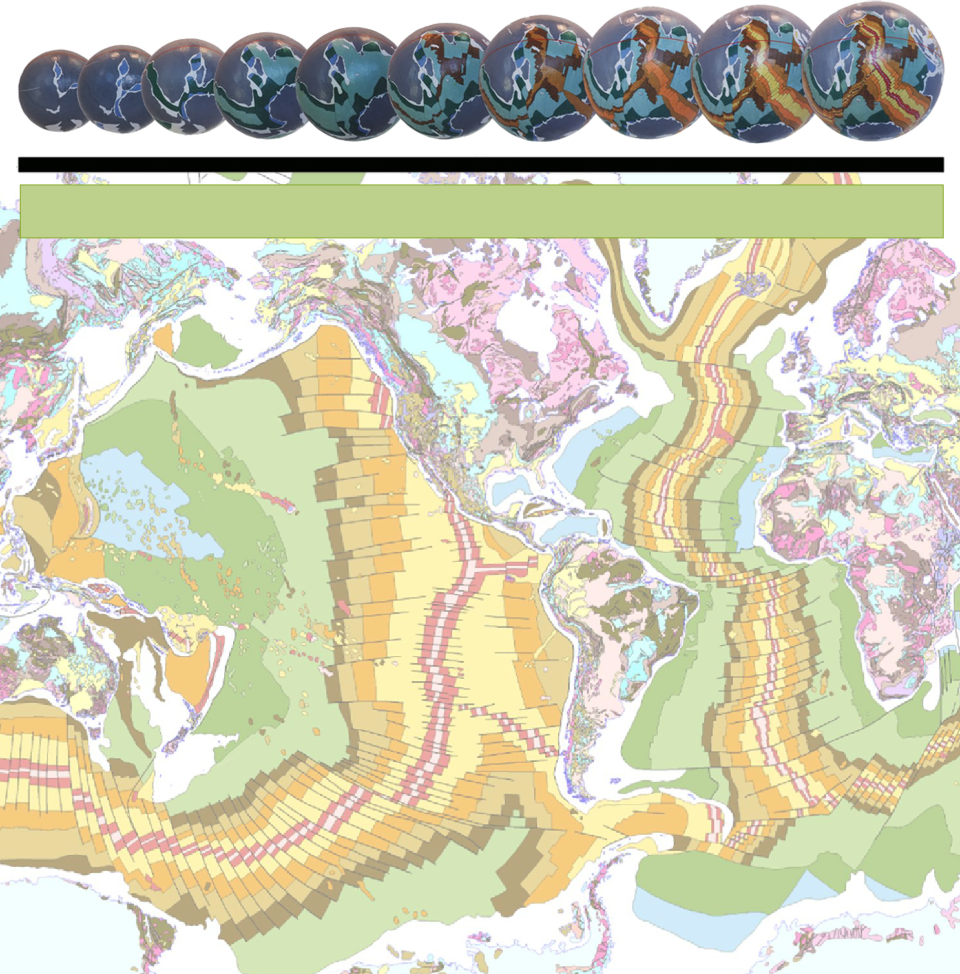ARCTIC OCEAN
On Expansion Tectonic small Earth models the Arctic Ocean originated as a very ancient marine sedimentary basin which first formed and commenced opening as the ancient Pangaea supercontinental crust started to rupture around 250 million years ago. This early Arctic Ocean basin was originally located in mid- to high-northern latitudes. Successive small Earth models then show that over time, as the ocean continued to open, the ocean basin and surrounding continents progressively migrated into the north polar-regions of today.

Arctic Ocean Expansion Tectonic small Earth spreading history, extending from the present-day back to the early-Jurassic.
On the small Earth models above it can be seen that the older Arctic Ocean shown in the lower right models is made up of a large expanse of marine sediments, shown as white areas located around the margins of the ancient continents, plus two seafloor basins shown as green colours. These green coloured seafloor basins are called the Amerasia and Eurasia Basins. The basins are Cretaceous in age and are shown to crosscut and displace the extensive white areas of marine sediments which were first deposited along the newly emerging continental shelf margins prior to exposure and preservation of the volcanic seafloor crusts.
On an Expansion Tectonic Earth, opening of the Arctic Ocean occurred as a result of crustal rupture and break-up of the ancient Pangaea supercontinent located between the newly formed North American and European continents. This break-up was then followed by on-going seafloor crustal stretching and opening of the Arctic Ocean within this region. The initially small Arctic Ocean basin progressively increased in surface area and its boundaries continued to extend further to the southeast during the Mesozoic Era.
The presence of exposed coloured seafloor crustal rocks within the Amerasia and Eurasia Basins shows that there was an initial period of seafloor spreading in each of these areas during the Cretaceous Period. The lack of any further seafloor crusts suggest that spreading then effectively ceased during late-Cretaceous times. Today, there are no active spreading centres in the older Arctic Ocean regions. Spreading is now located within the adjoining Nansen-Gakkel mid-ocean-ridge, which is a northern extension of the North Atlantic Ocean mid-ocean spreading ridge.
From the late-Cretaceous to the present-day the North Atlantic mid-ocean-ridge continued to extended into the Arctic Ocean region, crosscutting pre-existing marine sedimentary basins in this area. This progression into the Arctic Ocean gave rise to further fragmentation of the ancient continental crust and opening of new oceans located between Greenland, Canada, and Russia. During this opening phase, sediments eroded from the lands were initially deposited within the early Arctic Ocean basin. Deposition of sediments then progressively changed from deposition within a shallow marine basin to deposition within marine continental shelf settings which then bordered a true deep-ocean-spreading ridge.
Throughout much of this time the present-day Alaskan and Siberian Peninsulas remained joined, forming an important land-connection between the two continents and effectively isolating the Arctic Ocean from the emerging Pacific Ocean. During this lengthy period of time there was also continental crustal stretching between the two land masses, which was accompanied by faulting along each of the peninsulas during opening of the Arctic Ocean basins. The continental crust that now makes up Greenland and the Canadian Arctic Islands also fragmented during this time and these fragments began to gradually rift apart as the oceans continued to open.
From 66 million years ago to the present-day the Arctic Ocean basin was characterised by an on-going phase of symmetric-style mid-ocean-ridge seafloor and continental crustal extension and opening. This phase has resulted in further separation of the Canadian Arctic Islands, opening of Hudson Bay, and further rifting between Greenland and Canada. Separation of the Alaskan and Siberian Peninsulas across the Bering Strait occurred within the past 2 million years and this crustal separation, rifting, and extension is continuing to the present-day.


